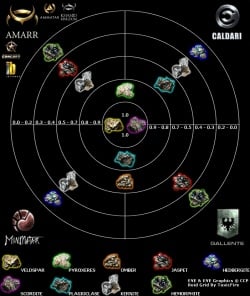Asteroids and ore
This article or section is in the process of an expansion or major restructuring. You are welcome to assist in its construction by editing it as well.
If this article or section has not been edited in several days, please remove this template.
Ore is the basic material found in the various asteroid fields throughout EVE. In their native form asteroid ores cannot be used, but must be refined into minerals, which can then be used for ship and equipment manufacture.
Where to find asteroids
Each mineable asteroids contains only one kind of ore, and they can be found in:
- Asteroid belts
- Deadspace pockets
- Cosmic anomalies
Virtually every star system (with the notable exception of Jita) in Eve has at least one asteroid belt, and most star systems have several (to up to tens in some cases). These belts are listed on the overview and the right-click menu, and always have the same geometry: a rough semicircle of asteroids. A given belt will have a mixture of asteroids containing different ores; the mixture and the size of the asteroids (i.e. how much ore each asteroid contains) is determined by the system's location in the Eve universe and its security status. The asteroids in an asteroid belt will respawn after downtime. The websites Ombeve and Dotlan have maps showing the number of asteroid belts per system.
Mineable asteroids can also spawn in deadspace pockets, such as the ones created for missions. Unlike asteroid belts, these are not organised into a set shape; some are composed of dense clumps of asteroids, while others are scattered fields. For a list of which missions' deadspace pockets contain asteroids, see Mission Mining or Eve-survival.
Lastly, one of the two kinds of cosmic anomaly contains asteroids (the other contains hostile rats). The asteroids in cosmic anomalies tend to be a little larger and contain rarer ore than the normal asteroid belts in a star system; however, unlike asteroid belts, once all the asteroids in the anomaly have been mined, the anomaly disappears.
Note that in many locations you will find decorative asteroids, which cannot be mined (or otherwise interacted with); these will have colourful names such as "Snake-shaped Asteroid".
Asteroid distribution
The Eve universe can be divided into four quarters:
- The Amarr quarter (includes systems held by the Amarr, Amatarr, Khanid, Blood Raider, and Sansha)
- The Caldari quarter (includes systems held the Caldari and Guristas)
- The Gallente quarter (includes systems held by the Gallente and Serpentis)
- The Minmatar quarter (includes systems held by the Minmatar and Angel Cartel)
Each of these four quarters has its own set of asteroid types. Additionally, the lower the security status of a system, the rarer the asteroid types that can be found there. Finally, each system can also include all the asteroid types of same-quarter higher-security systems; e.g. a Gallente system with a security rating of 0.7 will not only include Omber asteroids, but also Veldspar, Scordite, and Plagioclase asteroids.
In general, the rarer the ore, the higher its volume per unit (e.g. one unit of Veldspar has a volume of 0.1 m3, whereas one unit of Arkonor has a volume of 16 m3). Since mining lasers mine a given volume of ore per minute, it takes longer to mine the rarer ore types. Additionally, each ore refines into a different set of minerals; for details, see Refining.
Ice follows a similar geographic distribution to ore; for details, see Ice Mining.
Ore variants
Each asteroid type has two further subtypes, which yield more (+5% / +10%) minerals when refined. Otherwise they are identical in every way to their base ore, and are found in the same regions (just in lower concentrations). For instance, if an asteroid belt has Omber asteroids, it will also have some Silvery Omber asteroids and a few Golden Omber asteroids. If you get the chance, you should always mine the higher-yield variants before mining the base ore.
| Base ore | +5% variant | +10% variant |
|---|---|---|
| Veldspar | Concentrated Veldspar | Dense Veldspar |
| Scordite | Condensed Scordite | Massive Scordite |
| Pyroxeres | Solid Pyroxeres | Viscous Pyroxeres |
| Plagioclase | Azure Plagioclase | Rich Plagioclase |
| Omber | Silvery Omber | Golden Omber |
| Kernite | Luminous Kernite | Fiery Kernite |
| Jaspet | Pure Jaspet | Pristine Jaspet |
| Hemorphite | Vivid Hemorphite | Radiant Hemorphite |
| Hedbergite | Vitric Hedbergite | Glazed Hedbergite |
| Gneiss | Iridescent Gneiss | Prismatic Gneiss |
| Dark Ochre | Onyx Ochre | Obsidian Ochre |
| Spodumain | Bright Spodumain | Gleaming Spodumain |
| Crokite | Sharp Crokite | Crystalline Crokite |
| Bistot | Triclinic Bistot | Monoclinic Bistot |
| Arkonor | Crimson Arkonor | Prime Arkonor |
| Mercoxit | Magma Mercoxit | Vitreous Mercoxit |
